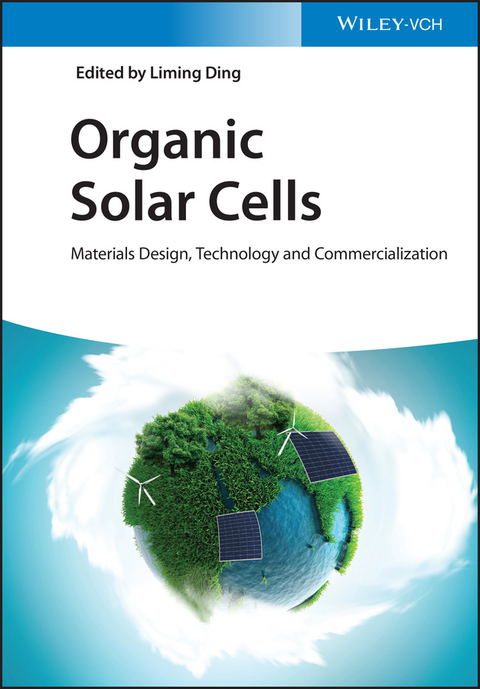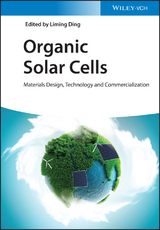Organic Solar Cells
Wiley-VCH (Verlag)
978-3-527-34933-3 (ISBN)
Liming Ding got his PhD from University of Science and Technology of China. He started his research on OSCs and PLEDs in Olle Inganäs Lab in 1998. Later on, he worked at National Center for Polymer Research, Wright-Patterson Air Force Base and Argonne National Lab (USA). He joined Konarka as a Senior Scientist in 2008. In 2010, he joined National Center for Nanoscience and Technology as a full professor. His research focuses on innovative materials and devices. He has published 341 papers on Science, Joule, Energy Environ Sci, Angew Chem, Sci Bull, Nature Comm, Adv Mater, Adv Energy Mater, etc. He is RSC Fellow, the nominator for Xplorer Prize, and the Associate Editors for Science Bulletin and Journal of Semiconductors.
1 CONJUGATED POLYMER DONORS FOR ORGANIC SOLAR CELLS
1.1 Introduction
1.2 LBG polymers
1.3 MBG polymers
1.4 WBG polymers
1.5 Summary and outlook
2 P-TYPE MOLECULAR PHOTOVOLTAIC MATERIALS
2.1 Introduction
2.2 p-Type Molecular Photovoltaic Materials Used in Vacuum-Deposited Solar Cells
2.3 p-Type Molecular Photovoltaic Materials Used in Solution-Processed Solar Cells
2.4 Current Progress on Small Molecule Solar Cells with Nonfullerene Acceptors with Nonfullerene
2.5 Summary and Outlook
3 FULLERENE ACCEPTORS
3.1 Introduction
3.2 Fullerene acceptors for organic solar cells
3.3 Summary
4 NON-FULLERENE SMALL MOLECULE ACCEPTORS FOR ORGANIC SOLAR CELLS
4.1 Molecular design principles
4.2 PDI-based SMAs
4.3 A-D-A type SMAs
4.4 A-DA?D-A type SMAs
5 ELECTRON-DONATING LADDER-TYPE HETEROACENES FOR PHOTOVOLTAIC APPLICATIONS: FROM POLYMER DONOR MATERIALS TO SMALL-MOLECULE ACCEPTOR MATERIALS
5.1 Introduction
5.2 D-A copolymers based on ladder-type heteroacenes
5.3 A-D-A NFAs based on ladder-type heteroacenes
5.4 Conclusions and outlook
6 CHLORINATED ORGANIC SOLAR CELLS
6.1 Introduction
6.2 Chlorination vs. Fluorination: Study on Comprehensive Characteristic
6.3 Recent advances in Chlorinated Semiconductor
6.4 Conclusion and Outlook
7 POLYMER-POLYMER SOLAR CELLS: MATERIALS, DEVICE AND STABILITY
7.1 Introduction
7.2 The Device Structure and Basic Principles of All-PSC
7.3 Materials Design towards Efficient All-PSCs
7.4 Device Performance and Stability of All-PSCs
7.5 Conclusion and Outlook
8 ORGANIC SOLAR CELLS WITH HIGH OPEN-CIRCUIT VOLTAGE >1 V
8.1 Introduction
8.2 n-type small molecule acceptors
8.3 n-type polymers
8.4 Conclusion and Outlook
9 SINGLE-COMPONENT ORGANIC SOLAR CELLS
9.1 Introduction
9.2 Single-component conjugated materials for SCOSCs
9.3 Morphological studies of the photo-active layers in the SCOSCs
9.4 Perspective and challenges of SCOSCs
10 TANDEM ORGANIC SOLAR CELLS: RECENT PROGRESS AND CHALLENGE
10.1 Introduction
10.2 Active Layer Materials in tandem OSCs
10.3 Interconnecting Layer Materials
10.4 The semi-empirical analysis of tandem OSCs
10.5 Conclusion and outlook
11 LARGE-AREA FLEXIBLE ORGANIC SOLAR CELLS
11.1 Introduction
11.2 Material Requirements for Large-area Flexible Organic Solar Cells
11.3 Flexible Electrode and Substrates
11.4 Large-area Flexible Device Fabrication
11.5 Efficiency Loss in Large-Area Devices and Modules
11.6 Conclusion and Outlook
12 ORGANIC PHOTOVOLTAICS FOR INDOOR APPLICATIONS
12.1 Introduction
12.2 The characteristics of indoor lighting sources
12.3 Testing system and parameters for indoor OPVs
12.4 Research progresses
12.5 Summary and prospective
13 INTERFACIAL DESIGN FOR EFFICIENT ORGANIC SOLAR CELLS
13.1 Introduction
13.2 The mechanism and effect of interfacial design
13.3 Anode interlayer materials
13.4 Cathode interlayer materials
13.5 Conclusion and outlook
14 MORPHOLOGICAL CHARACTERIZATION AND MANIPULATION OF ORGANIC SOLAR CELLS
14.1 Introduction
14.2 Morphological Characterization of Organic Solar Cells
14.3 Morphological Manipulation of Organic Solar Cells
14.4 Conclusion
15 OPERATIONAL STABILITY AND BUILT-IN POTENTIAL IN ORGANIC SOLAR CELLS
15.1 Introduction
15.2 Bimolecular recombination in organic solar cells
15.3 Metal/organic interfacial exciton dissociation in organic solar cells
15.4 Improvement of charge collection and performance reproducibility
15.5 Effect of built-in potential on stability of organic solar cells
15.6 Summary
16 VOLTAGE LOSSES AND CHARGE TRANSFER STATES IN DONOR-ACCEPTOR ORGANIC SOLAR CELLS
16.1 The origin of Voc of solar cells
16.2 Voc of organic solar cells
16.3 Strategies to reduce Vnr and Vr in organic solar cells
16.4 Summary
17 STABILITY OF ORGANIC SOLAR CELLS: FROM FULLERENE DERIVATIVES TO NON-FULLERENE ACCEPTORS
17.1 Introduction
17.2 Factors limiting the stability of organic solar cells
17.3 Stability evaluation protocols
17.4 Progress in developing stable organic solar cells
17.5 Recent progress on developing organic solar cells with excellent stability
17.6 Summary and outlook
18 POTENTIAL APPLICATIONS OF ORGANIC SOLAR CELLS
18.1 Introduction
18.2 Building-integrated OSCs
18.3 Wearable-integrated OSCs
18.4 OSCs-integrated energy storage system
18.5 Other applications
18.6 Conclusion and Outlook
| Erscheinungsdatum | 05.03.2022 |
|---|---|
| Verlagsort | Weinheim |
| Sprache | englisch |
| Maße | 170 x 244 mm |
| Gewicht | 666 g |
| Themenwelt | Naturwissenschaften ► Chemie |
| Technik ► Elektrotechnik / Energietechnik | |
| Technik ► Maschinenbau | |
| Schlagworte | Electrical & Electronics Engineering • Electronic materials • Elektronische Materialien • Elektrotechnik u. Elektronik • Energie • Energy • Materialien f. Energiesysteme • Materials for Energy Systems • Materials Science • Materialwissenschaften • Organischer Halbleiter • Solarenergie • Solarenergie u. Photovoltaik • Solar Energy & Photovoltaics • Solarzelle |
| ISBN-10 | 3-527-34933-2 / 3527349332 |
| ISBN-13 | 978-3-527-34933-3 / 9783527349333 |
| Zustand | Neuware |
| Informationen gemäß Produktsicherheitsverordnung (GPSR) | |
| Haben Sie eine Frage zum Produkt? |
aus dem Bereich




